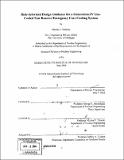Risk-informed design guidance for a Generation-IV gas-cooled fast reactor emergency core cooling system
Author(s)
Delaney, Michael J. (Michael James), 1979-
DownloadFull printable version (3.857Mb)
Other Contributors
Massachusetts Institute of Technology. Dept. of Nuclear Engineering.
Advisor
George E. Apostolakis.
Terms of use
Metadata
Show full item recordAbstract
Fundamental objectives of sustainability, economics, safety and reliability, and proliferation resistance, physical protection and stakeholder relations must be considered during the design of an advanced reactor. However, an advanced reactor's core damage frequency dominates all other considerations at the preliminary stage of reactor design. An iterative four-step methodology to guide the MIT gas-cooled fast reactor emergency core cooling system design through PRA insights was utilized based upon the preliminary stage of the reactor design and activities currently ongoing in the nuclear industry, regulator, and universities regarding advanced reactors. Advanced reactor designs also face an uncertain regulatory environment. It was concluded from the move towards risk- informed regulations of current reactors, that there will be some level of probabilistic insights in the regulations and supporting regulatory documents for advanced, "Generation-IV" nuclear reactors. The four-step methodology is moreover used to help designers analyze designs under potential risk-informed regulations and predict design justifications the regulator will require during the licensing process. The iterative design guidance methodology led to a reduction of the CDF contribution due to a LOCA of over three orders of magnitude from the baseline ECCS design (from 1.19x10-5 to 6.48x10-8 for the 3x100% loop configuration) and potential ECCS licensing issues were identified. This illustrates the value of formal design guidance based upon PRA.
Description
Thesis (S.M.)--Massachusetts Institute of Technology, Dept. of Nuclear Engineering, 2004. Includes bibliographical references (p. 75-77).
Date issued
2004Department
Massachusetts Institute of Technology. Department of Nuclear Engineering; Massachusetts Institute of Technology. Department of Nuclear Science and EngineeringPublisher
Massachusetts Institute of Technology
Keywords
Nuclear Engineering.